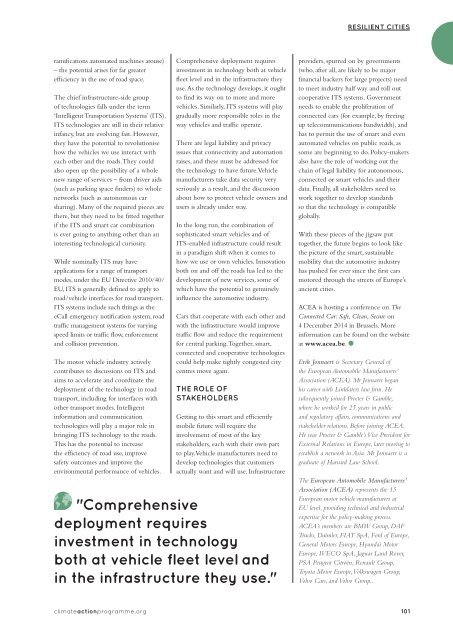Climate Action 2014-2015
You also want an ePaper? Increase the reach of your titles
YUMPU automatically turns print PDFs into web optimized ePapers that Google loves.
RESILIENT CITIES<br />
ramifications automated machines arouse)<br />
– the potential arises for far greater<br />
efficiency in the use of road space.<br />
The chief infrastructure-side group<br />
of technologies falls under the term<br />
‘Intelligent Transportation Systems’ (ITS).<br />
ITS technologies are still in their relative<br />
infancy, but are evolving fast. However,<br />
they have the potential to revolutionise<br />
how the vehicles we use interact with<br />
each other and the roads. They could<br />
also open up the possibility of a whole<br />
new range of services – from driver aids<br />
(such as parking space finders) to whole<br />
networks (such as autonomous car<br />
sharing). Many of the required pieces are<br />
there, but they need to be fitted together<br />
if the ITS and smart car combination<br />
is ever going to anything other than an<br />
interesting technological curiosity.<br />
While nominally ITS may have<br />
applications for a range of transport<br />
modes, under the EU Directive 2010/40/<br />
EU, ITS is generally defined to apply to<br />
road/vehicle interfaces for road transport.<br />
ITS systems include such things as the<br />
eCall emergency notification system, road<br />
traffic management systems for varying<br />
speed limits or traffic flow, enforcement<br />
and collision prevention.<br />
The motor vehicle industry actively<br />
contributes to discussions on ITS and<br />
aims to accelerate and coordinate the<br />
deployment of the technology in road<br />
transport, including for interfaces with<br />
other transport modes. Intelligent<br />
information and communication<br />
technologies will play a major role in<br />
bringing ITS technology to the roads.<br />
This has the potential to increase<br />
the efficiency of road use, improve<br />
safety outcomes and improve the<br />
environmental performance of vehicles.<br />
Comprehensive deployment requires<br />
investment in technology both at vehicle<br />
fleet level and in the infrastructure they<br />
use. As the technology develops, it ought<br />
to find its way on to more and more<br />
vehicles. Similarly, ITS systems will play<br />
gradually more responsible roles in the<br />
way vehicles and traffic operate.<br />
There are legal liability and privacy<br />
issues that connectivity and automation<br />
raises, and these must be addressed for<br />
the technology to have future. Vehicle<br />
manufacturers take data security very<br />
seriously as a result, and the discussion<br />
about how to protect vehicle owners and<br />
users is already under way.<br />
In the long run, the combination of<br />
sophisticated smart vehicles and of<br />
ITS-enabled infrastructure could result<br />
in a paradigm shift when it comes to<br />
how we use or own vehicles. Innovation<br />
both on and off the roads has led to the<br />
development of new services, some of<br />
which have the potential to genuinely<br />
influence the automotive industry.<br />
Cars that cooperate with each other and<br />
with the infrastructure would improve<br />
traffic flow and reduce the requirement<br />
for central parking. Together, smart,<br />
connected and cooperative technologies<br />
could help make tightly congested city<br />
centres move again.<br />
THE ROLE OF<br />
STAKEHOLDERS<br />
Getting to this smart and efficiently<br />
mobile future will require the<br />
involvement of most of the key<br />
stakeholders, each with their own part<br />
to play. Vehicle manufacturers need to<br />
develop technologies that customers<br />
actually want and will use. Infrastructure<br />
"Comprehensive<br />
deployment requires<br />
investment in technology<br />
both at vehicle fleet level and<br />
in the infrastructure they use."<br />
providers, spurred on by governments<br />
(who, after all, are likely to be major<br />
financial backers for large projects) need<br />
to meet industry half way and roll out<br />
cooperative ITS systems. Government<br />
needs to enable the proliferation of<br />
connected cars (for example, by freeing<br />
up telecommunications bandwidth), and<br />
has to permit the use of smart and even<br />
automated vehicles on public roads, as<br />
some are beginning to do. Policy-makers<br />
also have the role of working out the<br />
chain of legal liability for autonomous,<br />
connected or smart vehicles and their<br />
data. Finally, all stakeholders need to<br />
work together to develop standards<br />
so that the technology is compatible<br />
globally.<br />
With these pieces of the jigsaw put<br />
together, the future begins to look like<br />
the picture of the smart, sustainable<br />
mobility that the automotive industry<br />
has pushed for ever since the first cars<br />
motored through the streets of Europe’s<br />
ancient cities.<br />
ACEA is hosting a conference on The<br />
Connected Car: Safe, Clean, Secure on<br />
4 December <strong>2014</strong> in Brussels. More<br />
information can be found on the website<br />
at www.acea.be. <br />
Erik Jonnaert is Secretary General of<br />
the European Automobile Manufacturers’<br />
Association (ACEA). Mr Jonnaert began<br />
his career with Linklaters law firm. He<br />
subsequently joined Procter & Gamble,<br />
where he worked for 25 years in public<br />
and regulatory affairs, communications and<br />
stakeholder relations. Before joining ACEA,<br />
He was Procter & Gamble’s Vice President for<br />
External Relations in Europe, later moving to<br />
establish a network in Asia. Mr Jonnaert is a<br />
graduate of Harvard Law School.<br />
The European Automobile Manufacturers’<br />
Association (ACEA) represents the 15<br />
European motor vehicle manufacturers at<br />
EU level, providing technical and industrial<br />
expertise for the policy-making process.<br />
ACEA’s members are BMW Group, DAF<br />
Trucks, Daimler, FIAT SpA, Ford of Europe,<br />
General Motors Europe, Hyundai Motor<br />
Europe, IVECO SpA, Jaguar Land Rover,<br />
PSA Peugeot Citroën, Renault Group,<br />
Toyota Motor Europe, Volkswagen Group,<br />
Volvo Cars, and Volvo Group..<br />
climateactionprogramme.org 101












